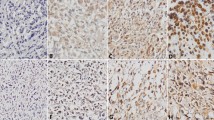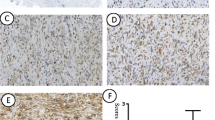Abstract
Twist, a basic helix-loop-helix transcription factor, and E-cadherin are both correlated with the metastatic progression of several types of cancer. However, it is currently unknown whether their activations have relevance to the progression of osteosarcoma. The purpose of the present study was to investigate the clinicopathological and prognostic value of Twist and E-cadherin in osteosarcoma. Twist and E-cadherin expressions were determined by immunohistochemistry. Patient survival rates were determined by Kaplan–Meier method and log-rank test. Cox regression was adopted for multivariate analysis of prognostic factors. The positive rates of Twist and E-cadherin in 107 osteosarcoma specimens were 31.8 % (34/107) and 20.6 % (22/107), respectively. Twist expression was significantly correlated with that of E-cadherin (r = −0.209, P = 0.031). The positive expression of Twist and E-cadherin was significantly associated with metastasis in 107 osteosarcoma specimens (both P < 0.05). Patients with positive Twist expression had significantly poorer overall survival (OS; P < 0.05) and disease-free survival (DFS, P < 0.05) when compared with patients with the negative expression of Twist. Patients with positive expression of E-cadherin had significantly poorer OS (P < 0.05) when compared with patients with negative E-cadherin expression, but not a significantly poorer DFS (P = 0.081). On multivariate analysis, Twist expression and age were found to be independent prognostic factors for OS (both P < 0.05) and DFS (both P < 0.05). Our results suggest that Twist was expressed significantly more and E-cadherin significantly less in osteosarcoma with metastasis, and expression of both might be related to the prediction of metastasis potency and poor prognosis for patients with osteosarcoma.


Similar content being viewed by others
References
Yao Y, Dong Y, Lin F, et al. The expression of CRM1 is associated with prognosis in human osteosarcoma. Oncol Rep. 2009;21(1):229–35.
Jaffe N. Adjuvant chemotherapy in osteosarcoma: an odyssey of rejection and vindication. Cancer Treat Res. 2009;152:219–37.
Thisse B, El Messal M, Perrin-Schmitt F. The twist gene: isolation of a Drosophila zygotic gene necessary for the establishment of dorsoventral pattern. Nucleic Acids Res. 1987;15(8):3439–53.
Yang J, Mani SA, Donaher JL, et al. Twist, a master regulator of morphogenesis, plays an essential role in tumor metastasis. Cell. 2004;117(7):927–39.
Frixen UH, Behrens J, Sachs M, et al. E-cadherin-mediated cell–cell adhesion prevents invasiveness of human carcinoma cells. J Cell Biol. 1991;113(1):173–85.
Hirohashi S. Inactivation of the E-cadherin-mediated cell adhesion system in human cancers. Am J Pathol. 1998;153(2):333–9.
Castilla MA, Moreno-Bueno G, Romero-Perez L, et al. Micro-RNA signature of the epithelial-mesenchymal transition in endometrial carcinosarcoma. J Pathol. 2011;223(1):72–80.
Kwok WK, Ling MT, Lee TW, et al. Up-regulation of TWIST in prostate cancer and its implication as a therapeutic target. Cancer Res. 2005;65(12):5153–62.
Niu RF, Zhang L, Xi GM, et al. Up-regulation of Twist induces angiogenesis and correlates with metastasis in hepatocellular carcinoma. J Exp Clin Cancer Res. 2007;26(3):385–94.
Yuen HF, Chan YP, Wong ML, et al. Upregulation of twist in oesophageal squamous cell carcinoma is associated with neoplastic transformation and distant metastasis. J Clin Pathol. 2007;60(5):510–4.
Shin HW, Cho K, Kim DW, et al. Hypoxia-inducible factor 1 mediates nasal polypogenesis by inducing epithelial-to-mesenchymal transition. Am J Respir Crit Care Med. 2012;185(9):944–54.
Maestro R, Dei TAP, Hamamori Y, et al. Twist is a potential oncogene that inhibits apoptosis. Genes Dev. 1999;13(17):2207–17.
Hao L, Ha JR, Kuzel P, Garcia E, Persad S. Cadherin switch from E- to N-cadherin in melanoma progression is regulated by the PI3 K/PTEN pathway through Twist and Snail. Br J Dermatol. 2012;166(6):1184–97.
Bielack SS, Kempf-Bielack B, Delling G, et al. Prognostic factors in high-grade osteosarcoma of the extremities or trunk: an analysis of 1,702 patients treated on neoadjuvant cooperative osteosarcoma study group protocols. J Clin Oncol. 2002;20(3):776–90.
Paznekas WA, Cunningham ML, Howard TD, et al. Genetic heterogeneity of Saethre-Chotzen syndrome, due to TWIST and FGFR mutations. Am J Hum Genet. 1998;62(6):1370–80.
Xue G, Hemmings BA. Phosphorylation of basic helix-loop-helix transcription factor twist in development and disease. Biochem Soc Trans. 2012;40(1):90–3.
Qin Q, Xu Y, He T, Qin C, Xu J. Normal and disease-related biological functions of Twist1 and underlying molecular mechanisms. Cell Res. 2012;22(1):90–106.
Entz-Werle N, Stoetzel C, Berard-Marec P, et al. Frequent genomic abnormalities at TWIST in human pediatric osteosarcomas. Int J Cancer. 2005;117(3):349–55.
Entz-Werle N, Lavaux T, Metzger N, et al. Involvement of MET/TWIST/APC combination or the potential role of ossification factors in pediatric high-grade osteosarcoma oncogenesis. Neoplasia. 2007;9(8):678–88.
Entz-Werle N, Choquet P, Neuville A, et al. Targeted apc;twist double-mutant mice: a new model of spontaneous osteosarcoma that mimics the human disease. Transl Oncol. 2010;3(6):344–53.
Valsesia-Wittmann S, Magdeleine M, Dupasquier S, et al. Oncogenic cooperation between H-Twist and N-Myc overrides failsafe programs in cancer cells. Cancer Cell. 2004;6(6):625–30.
Yang MH, Wu KJ. TWIST activation by hypoxia inducible factor-1 (HIF-1): implications in metastasis and development. Cell Cycle. 2008;7(14):2090–6.
Guo Y, Xie J, Rubin E, et al. Frzb, a secreted Wnt antagonist, decreases growth and invasiveness of fibrosarcoma cells associated with inhibition of Met signaling. Cancer Res. 2008;68(9):3350–60.
Ding J, Zhang Z, Pan Y, Liao G, Zeng L, Chen S. Expression and significance of twist, e-cadherin, and n-cadherin in gastrointestinal stromal tumors. Dig Dis Sci. 2012. doi:10.1007/s10620-012-2186-4.
Fassina A, Cappellesso R, Guzzardo V, et al. Epithelial-mesenchymal transition in malignant mesothelioma. Mod Pathol. 2012;25(1):86–99.
Kawanishi J, Kato J, Sasaki K, Fujii S, Watanabe N, Niitsu Y. Loss of E-cadherin-dependent cell–cell adhesion due to mutation of the beta-catenin gene in a human cancer cell line, HSC-39. Mol Cell Biol. 1995;15(3):1175–81.
Christofori G, Semb H. The role of the cell-adhesion molecule E-cadherin as a tumour-suppressor gene. Trends Biochem Sci. 1999;24(2):73–6.
Shino Y, Watanabe A, Yamada Y, et al. Clinicopathologic evaluation of immunohistochemical E-cadherin expression in human gastric carcinomas. Cancer. 1995;76(11):2193–201.
Gabbert HE, Mueller W, Schneiders A, et al. Prognostic value of E-cadherin expression in 413 gastric carcinomas. Int J Cancer. 1996;69(3):184–9.
Heimann R, Lan F, McBride R, Hellman S. Separating favorable from unfavorable prognostic markers in breast cancer: the role of E-cadherin. Cancer Res. 2000;60(2):298–304.
Eckert MA, Yang J. Targeting invadopodia to block breast cancer metastasis. Oncotarget. 2011;2(7):562–8.
Yonemura Y, Nojima N, Kaji M, et al. E-cadherin and urokinase-type plasminogen activator tissue status in gastric carcinoma. Cancer. 1995;76(6):941–53.
Shun CT, Wu MS, Lin JT, et al. An immunohistochemical study of E-cadherin expression with correlations to clinicopathological features in gastric cancer. Hepatogastroenterology. 1998;45(22):944–9.
Yonemura Y, Endou Y, Kimura K, et al. Inverse expression of S100A4 and E-cadherin is associated with metastatic potential in gastric cancer. Clin Cancer Res. 2000;6(11):4234–42.
Uchikado Y, Okumura H, Ishigami S, et al. Increased Slug and decreased E-cadherin expression is related to poor prognosis in patients with gastric cancer. Gastric Cancer. 2011;14(1):41–9.
Kashima T, Nakamura K, Kawaguchi J, et al. Overexpression of cadherins suppresses pulmonary metastasis of osteosarcoma in vivo. Int J Cancer. 2003;104(2):147–54.
Huber MA, Kraut N, Beug H. Molecular requirements for epithelial-mesenchymal transition during tumor progression. Curr Opin Cell Biol. 2005;17(5):548–58.
Acknowledgments
The authors thank Dr Yongbing Hu and Yahui Huang for their assistance with the evaluation of immunohistochemical staining.
Conflict of interest
All authors declared no conflict of interest.
Author information
Authors and Affiliations
Corresponding author
Rights and permissions
About this article
Cite this article
Yin, K., Liao, Q., He, H. et al. Prognostic value of Twist and E-cadherin in patients with osteosarcoma. Med Oncol 29, 3449–3455 (2012). https://doi.org/10.1007/s12032-012-0317-6
Received:
Accepted:
Published:
Issue Date:
DOI: https://doi.org/10.1007/s12032-012-0317-6




